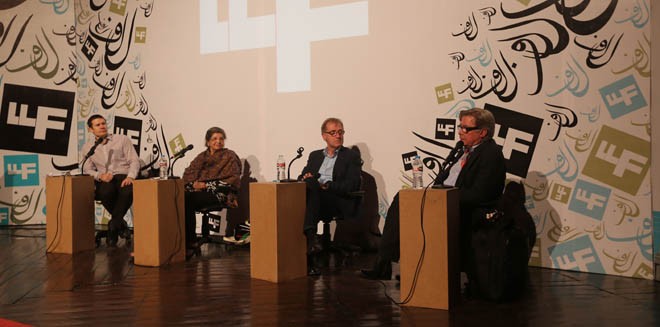

Last month, the Lahore Literary Festival took Punjab a step closer to starting an inclusive internal conversation which has so far been fragmented into three disjointed bubbles, each primarily conversing within its own limited boundary. The general stereotypical view of each of these realms through the eyes of the other is not flattering: the English bubble is considered elitist; the Urdu xenophobic subscribing to state ideology; and the Punjabi illiterate if not peripheral.
LFF 2014 included all three realms in its three-day programme, thus giving the people of Lahore an opportunity to become a part of them and thus judge them according to the discourse presented in their respective sessions.
The English realm has been consistently gaining since the privileged classes took to English medium schools and the O-levels system got firmly established as the better alternative. But the closure of whatever little English language electronic media there was indicates its limitation domestically. The question of identity within this realm seemed to fluctuate between the Islamic-Other or at times the South Asian-Other dichotomies while the Pakistani identity marker seemed less noticeable.
Further, the penetration of global market within this realm seemed to be creating two divergent aspects while promoting what can be considered a globalised individualistic identity: the more dominant trend seemed to be of authors acquiring and celebrating a celebrity status, unconcerned of the extent of their distance from the popular local reality.
But there was also a rebel outlier who put the question of this realm’s political and social alienation smack in the middle for its constituents by comparing Lahori participation in the ‘Baloch Missing Persons Long March’ a week before with his session at the LFF discussing the same issue. But more importantly, it is this realm which has kept the doors of communication alive between an increasingly insular Pakistan and the outside world, providing us access to the outsider’s perception of us.
The Urdu realm which can be accepted as representing the national discourse also bypassed class and the distinct regional reality of Pakistan as elements of discussion. The question of identity was discussed while critiquing the latest Gulf Arab influences in the garb of religion, though as a comparison it traced its identity to the Indian Muslim heritage. Thus, while negotiating an identity, this realm instinctively used religion as a marker by providing references to the Muslim elite (the ashrafia) of India and writers and poets linked to the same ashrafia.
The question of regional identity was by-passed by linking identity with those who had come from outside India and settled there to form a new Indo-Islamic realm. The Urdu realm thus provides a bridge between the Islamic and the Indian. But, by falling back on a historical minority elite culture representing an imagined nation which has since separated from India, it cannot break out of the perpetual cycle of negotiating between the Islamic and Indian identity.
Thus, it is on a slippery slope when trying to challenge any cultural influence with a religious garb.
The Punjabi (local) realm’s sessions were on the theme of resistance and both class and gender were subjects of discussion. But more importantly, in discussing Punjabi literature and realm’s representatives, identity was never negotiated. It concretely belonged to the land, was secular and traced itself from those who had fought or countered the invaders, irrespective of their religious association.
Given this realm’s clarity on the question of identity, instead class became the basic analytical category for its constituents raising a set of questions. The marginalised had the option to resist by representing class interests or instead concentrate on social mobility. Similarly, the privileged, while wanting change, did not want to give up their privileges, thus existing with a duality.
Overall, both the Punjabi sessions exuberated a sense of marginality as the realm had recently marked the Mother Language Day to highlight state’s disregard of their language and thus their identity by not allowing Punjabi or Seraiki in schools across the province.
Identity in Punjab as in other parts of Pakistan traverses the three realms of global, national and local. Development, the production of culture and discourse need to be informed by all three realms; else they can only be alienating or peripheral in today’s world and ill-equipped to take on the challenges of radicalisation and disempowerment.
LLF 2014 has taken the first step of bringing these realms in a collective space but stopped short of starting a conversation among them which hopefully will be the project of LLF 2015. It is only through a combined conversation of these realms that we can come to terms with our reality and find a common direction encompassing the strength of our diversity rather than being put in the basket of the post-colonial.